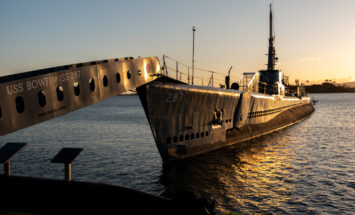USS Alaska (CB-1) Signalmen taking a visual message on the signal bridge, circa February 1945. Signalman Third Class Teddy Chalupski is writing the message while SM3/c Floyd H. Scharp reads it with the telescope. Note Scharp’s Equator crossing tattoo. Off
The art of tattooing has been practiced in early societies worldwide for thousands of years. It is believed that Captain James Cook’s voyages to the Pacific during the second half of the 18th century, exposed Royal Navy sailors to Polynesian body art. In fact, the word “tattoo” comes from the Polynesian word tatau, which phonetically imitated the sound of the rhythmic tapping of traditional tattoo instruments (usually needles fashioned from boar’s tusks) used to pierce a subject’s skin.
The popularity of tattoos spread quickly from British to American sailors. Staving off boredom during long hours at sea, sailors doubled as amateur tattooists. By the late 18th century, around a third of British and a fifth of American sailors had at least one tattoo. During the Civil War, tattoos commemorating the historic clash between the ironclads USS Monitor and CSS Virginia made their way into both navies, along with more general motifs such as military insignia and names of sweethearts. As newly tattooed Sailors returned home at war’s end, the work of Civil War–era tattooists spread around the country.
During World War I—in line with the Progressive era’s sense of higher purpose that also abolished alcohol rations in the Fleet—Navy recruits were strongly encouraged to get any risqué art covered up, since perceived “moral” failings might disqualify them from service. This was accomplished by having the offending (usually) female figure “dressed” or another design tattooed over it. Sailors also sought patriotic tattoos reflecting their enthusiasm for America’s participation in the conflict.
And although the Navy has a long and rich history of body art, many sailors bearing ink were still somewhat marginalized well into the 20th century. The vast expansion of the Navy during WWII laid the groundwork toward greater social acceptance of tattoos and ultimately toward body art’s embrace by the mainstream today. This, and the increasingly multicultural pool of recruits entering the Navy in the 21st century, led to the liberalization of regulations governing tattoos—the least restrictive among the U.S. branches of service.
TRADITIONAL SAILOR TATTOOS
Anchor: Originally indicated a mariner who had crossed the Atlantic. In the present day, an anchor in one form or another may be the first nautical tattoo a young Sailor acquires (often during his or her first liberty from boot camp) and is essentially an initiation rite into the naval service.
Braided rope/line: Usually placed around left wrist; indicates a deck division seaman.
Chinese/Asian dragon: Symbolizes luck and strength—originated in the pre–World War II Asiatic Fleet and usually indicated service in China. Much later, dragons came to symbolize WESTPAC service in general (also worn embroidered or as patches inside jumper cuffs and on cruise jackets).
Compass rose or nautical star: Worn so that a Sailor will always find his/her way back to port.
Crossed anchors: Often placed on the web between left thumb and forefinger; indicate a boatswain’s mate or boatswain (U.S. Navy rating badge).
Crossed ship’s cannon or guns: Signify naval vice merchant service; sometimes in combination with a U.S. Navy–specific or patriotic motif.
Crosses: In many variations—worn as a sign of faith or talisman. When placed on the soles of the feet, crosses were thought to repel sharks.
Dagger piercing a heart: Often combined with the motto “Death Before Dishonor”—symbolizes the end of a relationship due to unfaithfulness.
Full-rigged ship: In commemoration of rounding Cape Horn (antiquated).
Golden Dragon: Indicated crossing the international dateline into the “realm of the golden dragon” (Asia).
“Hold Fast” or “Shipmate”: Tattooed across knuckles of both hands so that the phrases can be read from left to right by someone standing opposite. Originally thought to give a seaman a firm grip on a ship’s rigging.
Hula girl and/or palm tree: On occasion, hula girls would be rendered in a risqué fashion; both tattoos indicated service in Hawaii.
Pig and rooster: This combination—pig on top of the left foot, rooster on top of the right—was thought to prevent drowning. The superstition likely hearkens back to the age of sail, when livestock was carried onboard ship. If a ship was lost, pigs and roosters—in or on their crates—floated free.
Shellback turtle: Indicates that a Sailor has crossed the equator. “Crossing the line” is also indicated by a variety of other themes, such as fancifully rendered geo-coordinates, King Neptune, mermaids, etc.
Ships’ propellers (screws): A more extreme form of Sailors’ body art: One large propeller is tattooed on each buttock (“twin screws”) to keep the bearer afloat and propel him or her back to home and loved ones.
Sombrero: Often shown worn by a girl. May have indicated service on ships homeported in San Pedro (Terminal Island, Los Angeles) or San Diego prior to World War II, a liberty taken in Tijuana, or participation in interwar Central and South American cruises.
Swallow: Each rendition originally symbolized 5,000 nautical miles underway; swallows were and still are displayed in various poses, often in combination with a U.S. Navy–specific motif or sweetheart’s/spouse’s name.


